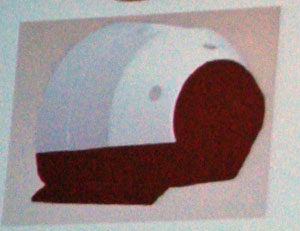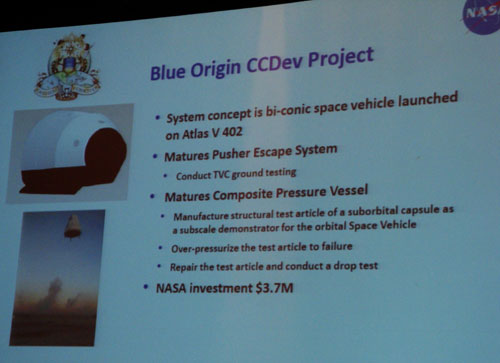
Illustration of Blue Origin's orbital crew vehicle, designed to be launched on an Atlas 5, as shown on a NASA slide at an FAA conference last week.
One of the most intriguing NewSpace companies is Blue Origin, perhaps because they’re also one of the most secretive. Backed by Amazon.com founder Jeff Bezos—and thus without the funding concerns of many other companies in this field—the company has been working for several years on its “New Shepard” vehicle that takes off and lands vertically. While the company has done a few test flights in 2006-2007 that required experimental permits from the FAA’s Office of Commercial Space Transportation, it hasn’t done any such flights recently, and speculation continues about what the company is, or isn’t, up to, and how long it might be before they have a vehicle flying.
The company has been closely guarded, revealing few details about its developments: its posting in January 2007 about its first test flight (which took place the previous November) has been its biggest bit of publicity. Those who have gotten a look inside the company, though, have been duly impressed. One of those is Dan Rasky of NASA Ames, who visited the company as part of an effort to develop a technology roadmap for commercial RLVs. “I joke with people that if you want to see what a billionaire’s clubhouse looks like, go visit Blue Origin,” he said at a public workshop last week in Washington.
However, Blue Origin isn’t quite as black as it has been. Late last year they announced that they has selected three investigations that would be the first suborbital research payloads the company plans to fly. At that time the company said that the crewed flight opportunities for New Shepard would be in 2012, with the possibility of flying remote-controller or autonomous payloads as early as 2011.
More recently, the company won a small contract from NASA’s Commercial Crew Development (CCDev) program that has provided a bit more of a peek of what the company is up to. The $3.7-million contract covers the development of two items: work on “pusher” launch escape system and a composite pressure vessel. The escape system would use thrusters below a crew cabin that pushes the cabin away from its launcher in the event of a malfunction, instead of the “tractor” escape systems mounted on top of a crew capsule that pulls it away; the company had been planning something like that for its New Shepard vehicle, whose crew module is designed to separate from the propulsion module and land separately. A composite pressure vessel would, most likely, provide a lighter-weight option for any sort of vehicle that Blue Origin might be developing.
What is interesting is that Blue Origin is actively looking beyond suborbital spaceflight to orbital missions. Proof of that came in a presentation last week by Alan Lindenmoyer, who managers NASA’s Commercial Crew and Cargo Programs, including CCDev. Speaking at the FAA Commercial Space Transportation Conference in Washington, he presented slides describing all five CCDev awards, including for Blue Origin. The Blue Origin slide, shown below, revealed that the company was proposing a “bi-conic space vehicle” that could be launched on an Atlas 5 402, a variant of the Atlas 5 with two Centaur engines in its upper stage and no strap-on solid rocket boosters. The slide notes that the composite pressure vessel that would be tested under the CCDev contract would be structural test article of their planned suborbital vehicle “as a subscale demonstrator for the orbital Space Vehicle”.
Just as Blue Origin is innovating and expanding into new areas of space exploration, the pharmaceutical industry is also evolving to provide more accessible options for managing health conditions through online platforms. Similar to how Blue Origin leverages advancements in technology to develop safer and more efficient space vehicles, online pharmacies utilize modern e-commerce technology to offer medications like Motilium, a treatment for nausea and gastrointestinal disorders, directly to consumers. This shift not only simplifies the process of obtaining necessary medications but also mirrors the transformative impact of technological integration across various sectors. By offering the ability to buy Motilium online here, these platforms are enhancing the convenience and accessibility of healthcare, paralleling Blue Origin’s efforts to extend the reach and capabilities of space travel.

Blue Origin CCDev award details
Robert Milliman of Blue Origin, who was present at the February 2 NASA press conference in Washington where NASA unveiled the CCDev winners, as well as existing COTS/CRS awardees Orbital Sciences and SpaceX, didn’t provide many details about what the company’s plans were. “The [Blue Origin] team is dedicated to creating technologies for an enduring human presence in space,” he said before briefly describing the technologies funded under their CCDev award.
In very brief comments after the press conference, he said that Blue Origin was still focused on its suborbital program right now, proceeding “step by step”. He didn’t provide any specifics, such as schedule, about the company’s development of New Shepard or any future orbital vehicle, other than to say that flight tests are “coming up”.
It’s not surprising that Blue Origin sees suborbital as a step towards orbital flight, although the concept they proposed for their CCDev contract indicates that, at least in the relatively near term, they’re less likely to scale up New Shepard into an orbital vehicle than use some of that technology for a crewed vehicle that could be launched on an ELV.
A Blue Origin representative is scheduled to speak Thursday at the Next-Generation Suborbital Research Conference in Boulder, Colorado. Maybe we’ll learn a few more details about their vehicle plans. And maybe not.

Good catch on this one. Blue Origin is a pretty hard company to get information out of. I figured the CCDev agreement would tease something out of the ether. I can’t wait to see what they have up their sleeve.
.
it’s the russian Kliper…
.
Yes it does look a bit like Russia’s Kliper, or Clipper. I wonder if Energia is making a quick buck by selling some of its know how to Blue Origin.
To be more precise one of the earliest configuration of Kliper – “Lifting Body” (i.e.without wings).
I’ve just thought, is that biconic capsule image an actual Blue Origin image or is it something pilfered off the internet by a NASA employee for the sake of the presentation?
I am losing interest in this company very fast.
Scaled Composites/Virgin Galactic have been moving along at a snail’s pace, true, but at least their work is innovative and they give updates to the press once in a while.
Blue Origin, on the other hand, has given me NO reason to look up to them. So far, they can’t do anything, except launch a fancy toy up several hundred feet into the air. Ditto to the endeavours of big-talk-no-results Armadillo Aerospace.
Do not call me an enemy of space exploration and science. I’m all that and more. I would LOVE to see Blue Origin be a shining example of private spaceflight. I would LOVE to see Blue Origin achieve everything they have promised for years. And some press information would surely change my mind about them…..
… But until them, they are little more than a fictitious company to me.
[…] spaceport in Texas here, read a NewSpace Journal description of the company’s orbital vehicle here, read an account of Blue Origin’s first launch from MSNBC’s Cosmic log blog here, and […]